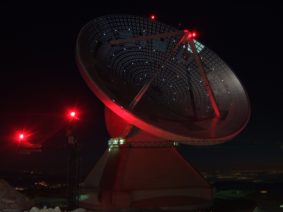Scientific Goals
The LMT is a major new astronomical facility, operating at short millimeter-wavelengths (1.1mm – 4mm) with good efficiency and capable of observations at 0.8mm under the best observing conditions. The LMT takes advantage of the combination of a primary aperture with a significant collecting area, offering high mapping-speeds and moderate angular resolutions (6 – 20 arcsecs), and the construction of the telescope on a high-altitude site (4600 meters). The completion of the installation of the 50-m diameter primary reflecting surface (in 2018), makes the LMT the world´s largest single-dish telescope designed specifically for astronomical observations at short millimeter wavelengths.
The broad scientific goal of the LMT is to contribute to improvements in our detailed understanding of the formation and evolution of structure, throughout the universe, during its entire history. More specifically, the LMT will:
- Map the anisotropies in the cosmic microwave background radiation, thus illuminating the nature, geometry and energy content of the universe;
- Detect hundreds of thousands of dust-obscured optically-faint galaxies during their major episodes of formation in the early universe to understand the origin and evolution of structure on the largest cosmological scales;
- Penetrate the dust, with millimeter-wavelength observations, that normally obscures the process of star formation in galaxies to define the full history of star formation over cosmic timescales;
- Study the variability and environments of active galactic nuclei to probe the central regions of these galaxies and the relationship between the accretion of material onto supermassive blackholes and the fueling of the star formation activity in their host galaxies;
- Observe sources exhibiting gamma-ray bursts to improve our knowledge of the finals stages of stellar evolution, and the origin of the heaviest chemical elements dispersed into the interstellar medium;
- Provide new insights into the nature and distribution of the interstellar gas and cold dust from which stars form in local & distant galaxies;
- Conduct millimeter-wavelength observations using Very Long Baseline Interferometry (VLBI) to test predictions on the physical properties (mass, spin, relativistic effects) of supermassive black holes at the centers of nearby galaxies (including the Milky Way);
- Survey large samples of gaseous and dust-rich circumstellar disks around nearby young stars to identify potential protoplanetary systems;
- Search for complex molecules in planetary atmospheres, interplanetary space and the interstellar medium, and conduct the first comprehensive millimeter-wavelength surveys of small solar-system objects (including Near-Earth objects, Main-belt asteroids, Centaurs and Kuiper-belt objects);
- Analyse the chemical and physical composition of comets which contain the primordial material from which the solar system was formed.
